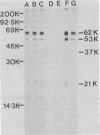Abstract
The rhesus monkey was used as a model for diseases caused by viruses of the tick-borne encephalitis virus complex to study the efficacy and safety of a commercial killed vaccine. Animals infected intravenously developed a subclinical infection with no histopathological lesions but with transient clinical chemical changes that included elevated transaminase, dehydrogenase, and creatine kinase activities and that declined as an immune response developed. The immune response was detected as neutralizing antibody in serum and serum antibody to several viral proteins. Antibodies to viral envelope protein and two other infected cell-specific polypeptides were also detected. Intranasal infection resulted in a disease resembling that in humans, except that no pyrexia was observed. Clinical chemical changes similar to those in intravenously infected monkeys developed, but most animals died before an immune response was mounted. Using this model, we have demonstrated that a commercial vaccine protects animals against a wild-type virus isolate and that it elicits an effective immune reaction without any evidence of an immune enhancement phenomenon or adverse side effects as judged by clinical observation, clinical chemistry, and histopathology.
Full text
PDF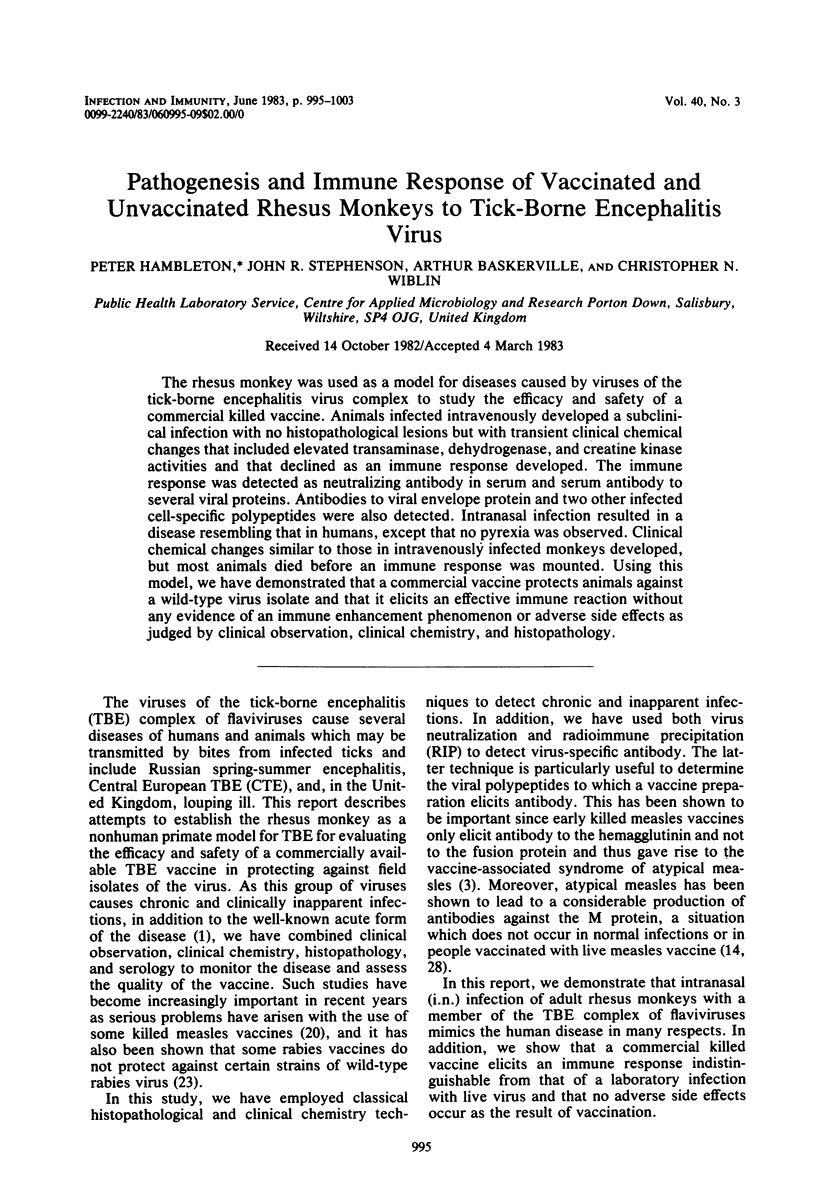
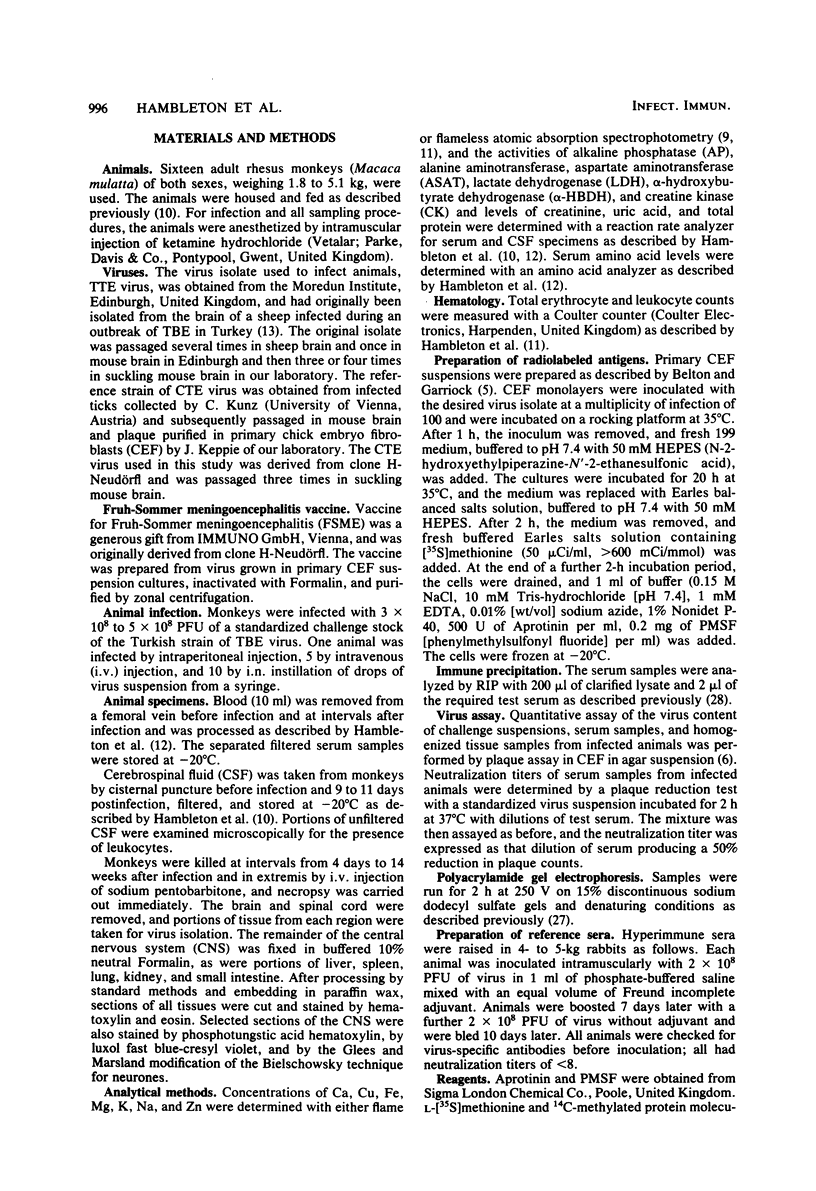





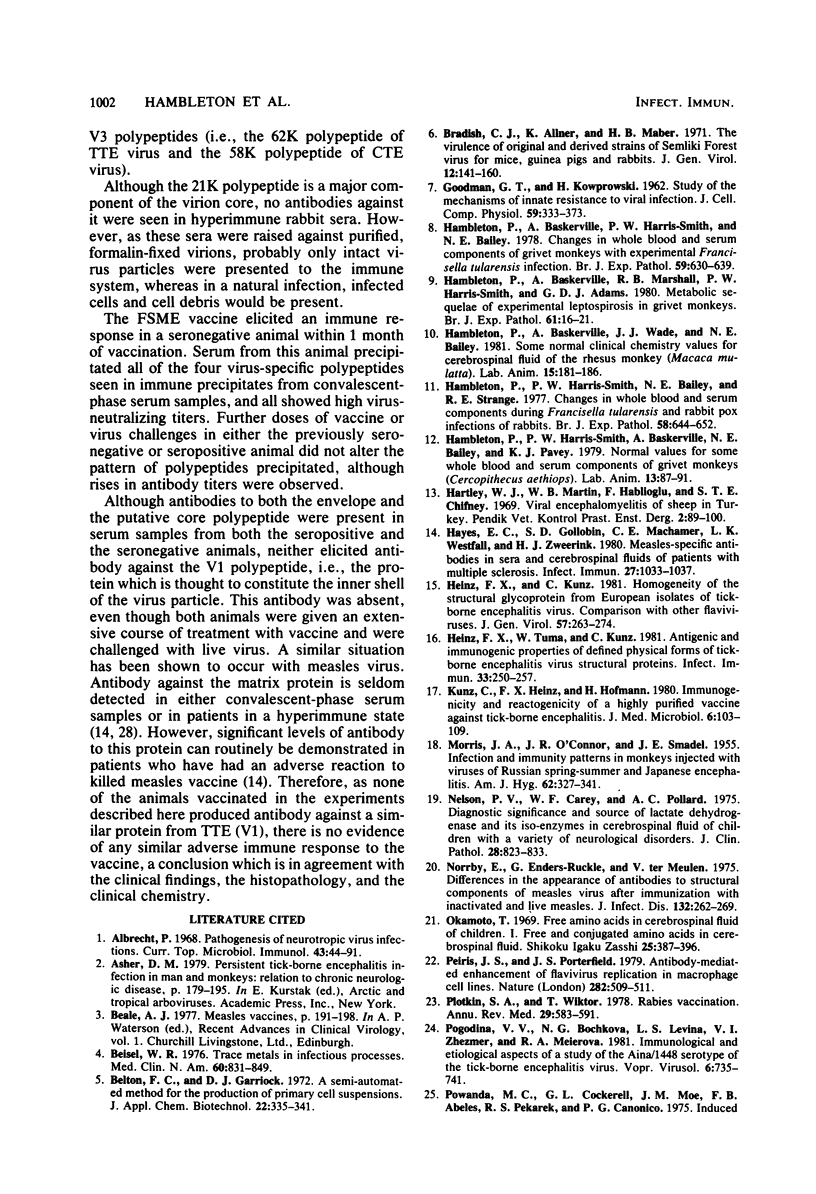
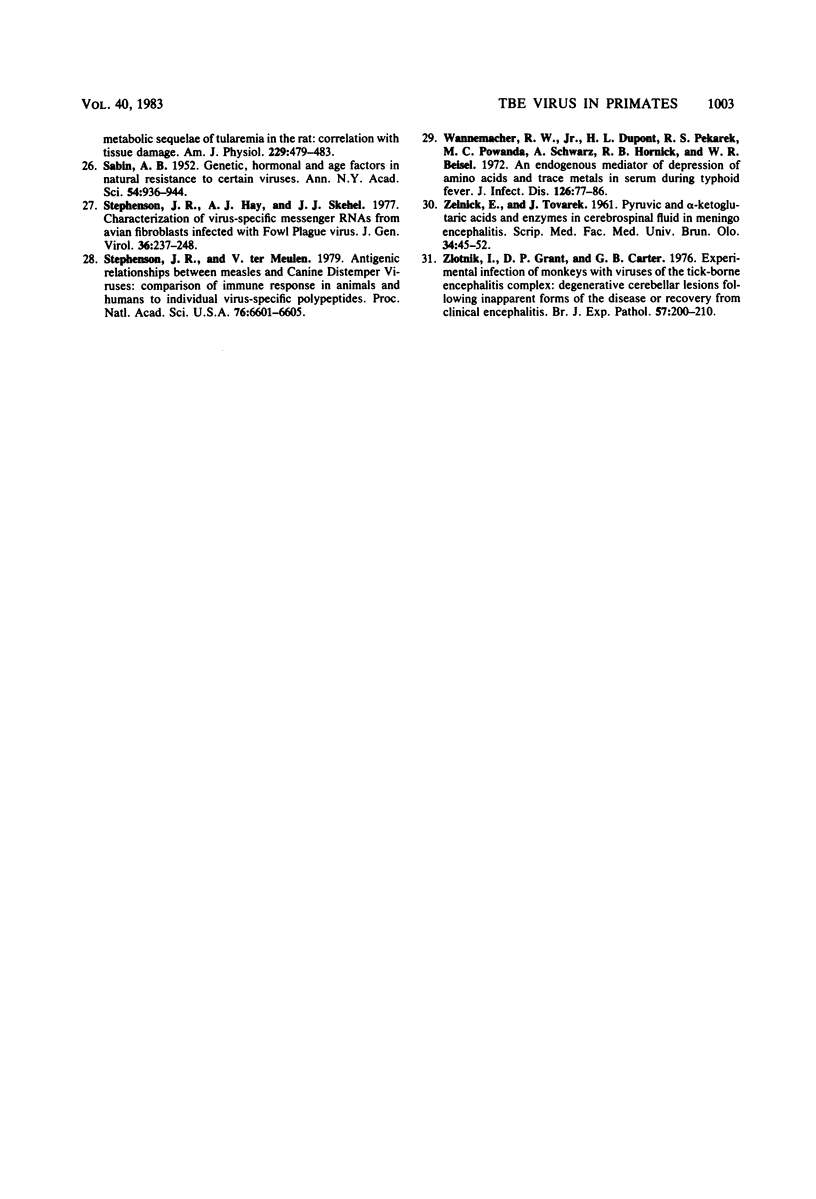
Images in this article
Selected References
These references are in PubMed. This may not be the complete list of references from this article.
- Albrecht P. Pathogenesis of neurotropic arbovirus infections. Curr Top Microbiol Immunol. 1968;43:44–91. doi: 10.1007/978-3-642-46118-7_2. [DOI] [PubMed] [Google Scholar]
- Beisel W. R. Trace element in infectious processes. Med Clin North Am. 1976 Jul;60(4):831–849. doi: 10.1016/s0025-7125(16)31864-8. [DOI] [PubMed] [Google Scholar]
- Bradish C. J., Allner K., Maber H. B. The virulence of original and derived strains of Semliki forest virus for mice, guinea-pigs and rabbits. J Gen Virol. 1971 Aug;12(2):141–160. doi: 10.1099/0022-1317-12-2-141. [DOI] [PubMed] [Google Scholar]
- GOODMAN G. T., KOPROWSKI H. Study of the mechanism of innate resistance to virus infection. J Cell Comp Physiol. 1962 Jun;59:333–373. doi: 10.1002/jcp.1030590313. [DOI] [PubMed] [Google Scholar]
- Hambleton P., Baskerville A., Harris-Smith P. W., Bailey N. E. Changes in whole blood and serum components of grivet monkeys with experimental respiratory Francisella tularensis infection. Br J Exp Pathol. 1978 Dec;59(6):630–639. [PMC free article] [PubMed] [Google Scholar]
- Hambleton P., Baskerville A., Marshall R. B., Harris-Smith P. W., Adams G. D. Metabolic sequelae of experimental leptospirosis in grivet monkeys. Br J Exp Pathol. 1980 Feb;61(1):16–21. [PMC free article] [PubMed] [Google Scholar]
- Hambleton P., Baskerville A., Wade J. J., Bailey N. E. Some normal clinical chemistry values for cerebrospinal fluid of the rhesus monkey (Macaca mulatta). Lab Anim. 1981 Apr;15(2):181–186. doi: 10.1258/002367781780959134. [DOI] [PubMed] [Google Scholar]
- Hambleton P., Harris-Smith P. W., Bailey N. E., Strange R. E. Changes in whole blood and serum components during Francisella tularensis and rabbit pox infections of rabbits. Br J Exp Pathol. 1977 Dec;58(6):644–652. [PMC free article] [PubMed] [Google Scholar]
- Hambleton P., Harris-Smith P. W., Baskerville A., Bailey N. E., Pavey K. J. Normal values for some whole blood and serum components of grivet monkeys (Cercopithecus aethiops). Lab Anim. 1979 Apr;13(2):87–91. doi: 10.1258/002367779780943585. [DOI] [PubMed] [Google Scholar]
- Hayes E. C., Gollobin S. D., Machamer C. E., Westfall L. K., Zweerink H. J. Measles-specific antibodies in sera and cerebrospinal fluids of patients with multiple sclerosis. Infect Immun. 1980 Mar;27(3):1033–1037. doi: 10.1128/iai.27.3.1033-1037.1980. [DOI] [PMC free article] [PubMed] [Google Scholar]
- Heinz F. X., Kunz C. Homogeneity of the structural glycoprotein from European isolates of tick-borne encephalitis virus: comparison with other flaviviruses. J Gen Virol. 1981 Dec;57(Pt 2):263–274. doi: 10.1099/0022-1317-57-2-263. [DOI] [PubMed] [Google Scholar]
- Heinz F. X., Tuma W., Kunz C. Antigenic and immunogenic properties of defined physical forms of tick-borne encephalitis virus structural proteins. Infect Immun. 1981 Jul;33(1):250–257. doi: 10.1128/iai.33.1.250-257.1981. [DOI] [PMC free article] [PubMed] [Google Scholar]
- Kunz C., Heinz F. X., Hofmann H. Immunogenicity and reactogenicity of a highly purified vaccine against tick-borne encephalitis. J Med Virol. 1980;6(2):103–109. doi: 10.1002/jmv.1890060202. [DOI] [PubMed] [Google Scholar]
- MORRIS J. A., O'CONNOR J. R., SMADEL J. E. Infection and immunity patterns in monkeys injected with viruses of Russian spring-summer and Japanese encephalitis. Am J Hyg. 1955 Nov;62(3):327–341. doi: 10.1093/oxfordjournals.aje.a119782. [DOI] [PubMed] [Google Scholar]
- Nelson P. V., Carey W. F., Pollard A. C. Diagnostic significance and source of lactate dehydrogenase and its isoenzymes in cerebrospinal fluid of children with a variety of neurological disorders. J Clin Pathol. 1975 Oct;28(10):828–833. doi: 10.1136/jcp.28.10.828. [DOI] [PMC free article] [PubMed] [Google Scholar]
- Norrby E., Enders-Ruckle G., Meulen V. Differences in the appearance of antibodies to structural components of measles virus after immunization with inactivated and live virus. J Infect Dis. 1975 Sep;132(3):262–269. doi: 10.1093/infdis/132.3.262. [DOI] [PubMed] [Google Scholar]
- Peiris J. S., Porterfield J. S. Antibody-mediated enhancement of Flavivirus replication in macrophage-like cell lines. Nature. 1979 Nov 29;282(5738):509–511. doi: 10.1038/282509a0. [DOI] [PubMed] [Google Scholar]
- Plotkin S. A., Wiktor T. Rabies vaccination. Annu Rev Med. 1978;29:583–591. doi: 10.1146/annurev.me.29.020178.003055. [DOI] [PubMed] [Google Scholar]
- Pogodina V. V., Bochkova N. G., Levina L. S., Zhezmer V. Iu, Meierova R. A. Immunologicheskie i nekotorye étiologicheskie aspekty izucheniia serotipa Aina/1448 virusa kleshchevogo éntsefalita. Vopr Virusol. 1981 Nov-Dec;(6):735–741. [PubMed] [Google Scholar]
- Powanda M. C., Cockerell G. L., Moe J. B., Abeles F. B., Pekarek R. S., Canonico P. G. Induced metabolic sequelae of tularemia in the rat: correlation with tissue damage. Am J Physiol. 1975 Aug;229(2):479–483. doi: 10.1152/ajplegacy.1975.229.2.479. [DOI] [PubMed] [Google Scholar]
- SABIN A. B. Genetic, hormonal and age factors in natural resistance to certain viruses. Ann N Y Acad Sci. 1952 Jul 10;54(6):936–944. doi: 10.1111/j.1749-6632.1952.tb39968.x. [DOI] [PubMed] [Google Scholar]
- Stephenson J. R., Hay A. J., Skehel J. J. Characterization of virus-specific messenger RNAs from avian fibroblasts infected with fowl plague virus. J Gen Virol. 1977 Aug;36(2):237–248. doi: 10.1099/0022-1317-36-2-237. [DOI] [PubMed] [Google Scholar]
- Stephenson J. R., ter Meulen V. Antigenic relationships between measles and canine distemper viruses: comparison of immune response in animals and humans to individual virus-specific polypeptides. Proc Natl Acad Sci U S A. 1979 Dec;76(12):6601–6605. doi: 10.1073/pnas.76.12.6601. [DOI] [PMC free article] [PubMed] [Google Scholar]
- Wannemacher R. W., Jr, DuPont H. L., Pekarek R. S., Powanda M. C., Schwartz A., Hornick R. B., Beisel W. R. An endogenous mediator of depression of amino acids and trace metals in serum during typhoid fever. J Infect Dis. 1972 Jul;126(1):77–86. doi: 10.1093/infdis/126.1.77. [DOI] [PubMed] [Google Scholar]
- Zlontnik I., Grant D. P., Carter G. B. Experimental infection of monkeys with viruses of the tick-borne encephalitis complex: degenerative cerebellar lesions following inapparent forms of the disease or recovery from clinical encephalitis. Br J Exp Pathol. 1976 Apr;57(2):200–210. [PMC free article] [PubMed] [Google Scholar]




